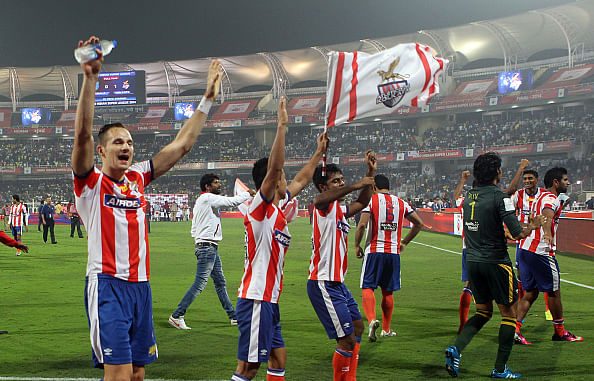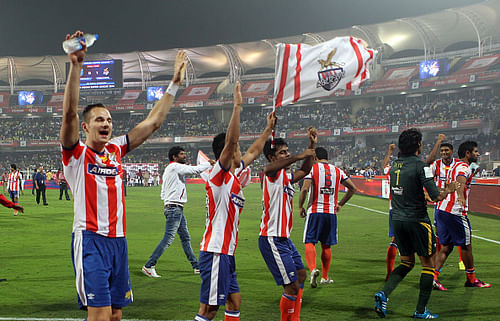
Did ISL really revolutionise Indian football?

The first edition of the Indian Super League (ISL) received an overwhelming response from football fans in India. Both stadium attendance and TV viewership returned encouraging figures for a football tournament in its inaugural year. Official figures suggest that the 10-week long tournament became the most watched football league in Asia ahead of competitions such as the Chinese Super League, J-League (Japan) and K-League (South Korea).
Apart from paying through their noses for the services of marquee players, the organisers (IMG-Reliance group) gave the Indian players their fair share of money. Italy’s Alessandro Del Piero is reported to have received around Rs 11 Cr while Indian players like Subrata Pal and Syed Rahim Nabi were paid Rs 80-lakh each.
The winners’ prize money was also lucrative. The promoters of the league even called it the “birth of Indian football”. Although we have witnessed several positive changes since ISL was launched, the football scene in India is far from “revolutionised”.
ISL must be combined with I-League
Firstly it may not be practical to run two parallel football leagues in a country at the same time as pointed out by the FIFA general secretary during a press conference conducted on October last year in Delhi. Jerome Valcke although had praised the ISL by calling it a “good platform for budding talent”, but refused to call it a league.
It is imperative that the football officials work on improving the state of the I-League to expect any wonders from Indian football. Recently released Fifa rankings show where India really stands – 171, our lowest ever.
Talks are rife that ISL and I-league may be merged into a single league in the near future. Such an amalgamation of football leagues may help both the leagues in the long run. ISL’s marketing side combined with the I-League’s local experience and grassroots reach could prove to be beneficial for India.
Player drafting system should be revised in ISL
In ISL, the ratio of foreign players to Indians was a bit unhealthy. Each team was allowed to play up to seven foreign players in ISL while the I-league allows a maximum of four international players, making the latter more focused on local talent.
Even the Brazilian legend Zico, who coached FC Goa in the 2014 ISL season, had said that the number of Indian players should be increased.
The Federation Cup, taking place in Mumbai at the moment, is a good place to analyse the impact of ISL on Indian players. Football commentator, Novy Kapadia has said that players like Arnab Mondal and Baljit Sahni are not being able, maintain the same intensity that they showed in the ISL. However, others like Romeo Fernandez have performed well.
This year’s ISL could not procure the services of AIFF Footballer of the Year Sunil Chettri due to differences between Bengaluru FC and ISL organisers. Players like Robin Singh, a Bengaluru FC player, have expressed interest in playing in ISL’s next edition, at the same time reiterating that the I-League has “a charm of its own”.
Many plans in the pipeline for I-League: AIFF
A former senior AIFF official, who spoke to this writer, said that the organization did not make any money through the ISL. Most of the Rs 700 Cr received from IMG-Reliance was used for paying off foreign players’ fee, the official said. If this statement is to be believed than major modifications have to be done with the way finance is managed in ISL.
The AIFF needs to generate funds to invest on grassroots projects. The money can also be used towards the improvement of tournaments like the Federation Cup, I-League and the Durand Cup (Asia’s oldest football tournament) that are suffering from lack of sponsorships. The ISL cannot be taken as an alternative to all these tournaments.
The I-League, which has “a charm of its own”, is played for a longer duration and tests the skills and temperament of Indian players. The I-League, however, needs to reinvent itself to attract crowds back to the stadium. This year the AIFF has announced that each I-League team has to sign at least one foreign marquee player. This, along with a new TV broadcasting contract with Ten Sports, are some positive changes to be looked forward to this year.
AIFF’s media wing also spoke to this writer and said, “We(AIFF) are on an ongoing process of modifying things to make them look better than before. The talk among the social media this time about the Hero I-League is more than ever.
We(AIFF) got Hero MotoCorp as our title sponsor this year and have many more plans as such – making an official app, launching a new website, and so on. Stay tuned.”
Expecting changes overnight would be impractical. Indian football has a long way to go before we can qualify for the world cup. Boosting the national league would be the first step in the process. The ISL may have lit a spark, it’s up to India’s footballing body to harness it effectively.